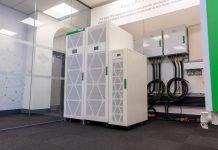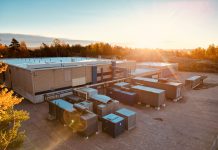 There is a growing trend towards the use of innovative cogeneration (CHP) systems for the onsite generation of power, especially in critical areas such as hospitals, hotels and universities. However, as John Hargreaves, technical sales manager at Wakefield Acoustics, explains, noise control must be a vital consideration during any installation in such heavily regulated applications
There is a growing trend towards the use of innovative cogeneration (CHP) systems for the onsite generation of power, especially in critical areas such as hospitals, hotels and universities. However, as John Hargreaves, technical sales manager at Wakefield Acoustics, explains, noise control must be a vital consideration during any installation in such heavily regulated applications
The very nature of mission critical environments means a resilient energy infrastructure is essential to day-to-day operations. As a result, such facilities typically have at least one form of backup generation on site, should they experience disruption to electricity supply through the National Grid and local distribution networks.
Many critical facilities are switching onto the benefits of combined heat and power (CHP) when it comes to generating their electricity onsite. In fact, such is the uptake of these systems, that about a quarter (26%) of businesses have already invested in onsite generation in the form of CHP and/or solar, with a third considering investing in these technologies in the future, according to a new study of more than 1,000 businesses conducted by Centrica Business Solutions.
There is no doubt that CHP systems have the potential to offer substantial operational and performance benefits for a range of critical environments. Their more efficient generation process, when compared with standard heat production systems, as well as the fact that electrical power can be exported to the National Grid when the CHP plant produces more than the site demands, makes such systems an ideal choice for critical sites.
What is more, heat produced from the system – which would otherwise be wasted when generating electrical or mechanical power – can also be used to match heat demand from a typical heating function.
By adopting such quick and easy to install systems, particularly on sites which rely on a constant supply of energy to maintain operations, energy managers can achieve savings in energy costs of up to 20% and reduce carbon emissions by as much as 30% – so it perhaps comes as little surprise that the uptake for CHP continues to grow in popularity throughout the UK, particularly with large organisations such as universities and hospitals.
However, consultants should also be aware – CHP systems typically operate using a main driver unit such as a gas engine, meaning there is potential for excessive and potentially harmful noise emissions.
In fact, typical continuous noise levels from prime mover gas engines within CHP systems can be as high as 100dB(A) to 110dB(A), significantly in excess of the maximum allowable noise levels of 85dB(A), for an exposure period of eight hours in any 24-hour period, as permitted within the UK’s Control of Noise at Work Regulations 2005.
Add to this the fact that onsite cogeneration systems are often situated in areas surrounded with solid surfaces, such as concrete and blockwork, and the build-up of reverberation could see this noise level rise a further 15dB(A). To put this increase into perspective for today’s critical environments, for every increase of 3dB(A), the allowable exposure time is halved. Therefore at 112dB(A), the allowable exposure time is reduced to just 56 seconds.
Organisations, therefore, must use the latest noise control solutions at their disposal to effectively mitigate noise; in turn, addressing both the associated health risks such as hearing loss, as well as ensuring they are compliant with environmental noise regulations imposed upon critical sites.
Acoustic enclosures
 As no two plant installations are the same, careful consideration must be given to each system’s function, location, permitted noise levels and much more, in order to determine the most effective noise control solution for the specific application. As a result, when it comes to specifying noise mitigation products for CHP systems in mission critical environments, there is no one-size-fits-all solution and a number of factors must be deliberated.
As no two plant installations are the same, careful consideration must be given to each system’s function, location, permitted noise levels and much more, in order to determine the most effective noise control solution for the specific application. As a result, when it comes to specifying noise mitigation products for CHP systems in mission critical environments, there is no one-size-fits-all solution and a number of factors must be deliberated.
Firstly, the majority of CHP systems installed in critical environments are situated within a building; significantly increasing the risk of exposure to breakout noise for both operators and visitors to the site. Second to this, local councils are becoming increasingly strict when it comes to environmental noise, imposing more stringent limits on noise emissions within critical facilities.
Full acoustic enclosures offer the best level of noise mitigation, and will ensure breakdown noise falls below levels set within Noise at Work Regulations; however, additional factors will likely need to be considered before installation.
The prime mover (heat engine), for instance, also has a gas exhaust which requires an exhaust silencer that can withstand the gas flow rate, its pressure and temperature. Combustion air from such systems is typically ducted into the area along with air for heat removal, necessitating further noise attenuation for both the supply and return ducts.
There may also be building ventilation, meaning the noise of the CHP plant’s pumps and motors could leak out through ventilation louvres. These must also be attenuated to meet the noise levels typically set by local councils.
At the same time, the engine of a CHP unit will emit significant heat and this must be considered along with the air combustion requirement of the engine, hence the use of fans.
For the majority of critical environments, space within a building is at a premium. Utilising acoustic enclosures ensures that plant items can be situated outdoors with cabling and piping running back to buildings as required. This frees up space to focus on core operational activities. In such installations, however, the associated ducting will have to be appropriately attenuated in order to meet environmental noise limits.
The 24/7 requirement for power generation on many critical sites undoubtedly has the potential to create considerable disruption when it comes to noise emissions from CHP plant items. By designing acoustic enclosures using heavier and composite panels, noise emissions can be attenuated to levels that are often in line with the background noise of the environment. This means cogeneration systems can be used in close proximity to buildings, housing or accommodation blocks and run 24 hours a day.
Maintenance of the plant must also be a primary concern, as the removal of critical parts such as the engine, pistons and motors may be required to maintain operational efficiency. To enable maintenance activities to take place, lifting beams can be included within the enclosure design, while maintenance doors or removable sections can be also be installed in the walls where necessary.
Materials and finish are also important, particularly in coastal or corrosive atmospheres. To alleviate the potentially harmful impacts of such environments on critical equipment, pre-galvanised sheet steel is used, which can also be painted. However, stainless steel or more exotic paint systems can also be used where appropriate.



